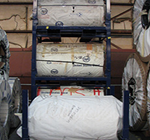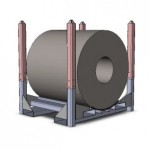Industrial Tire Racks - Types, Characteristics and Benefits
Racks are among the most important equipment used in any manufacturing industry. The main objective of a rack is to provide a safe and efficient storage solution to the products. Earlier, there were only a few types of racks. However, as the years passed, more and more advanced storage became the requirement of many industries. This gave rise to developing a wide range of storage solutions, with different storage capabilities, sizes, features, and properties.
Among the many types of racks used today, there is a type of rack, which is designed specifically for storing tires. These are the industrial tire racks. What are these racks exactly? Why are they so popular? Are these questions bothering you? Not for long, as this post is dedicated to answering all the questions that come to your mind about the industrial tire racks. Read on to know more.
What are Industrial Tire Racks?
Industrial tire racks, as the name suggests are designed to store tires in a variety of sizes, and weights. In order to store large tires, heavy-duty racking solutions are required, which consists of more metal and support as compared to regular racks. These are heavy-duty storage solutions, with a high load-bearing capacity, which are capable of handling and storing heavy tires. Whereas typical racks are less tough, the industrial racks used for storing tires have an excellent toughness. The racks are robust and capable of withstanding the rigors put on them by the tires used in construction equipment.
What are the Various Types of Industrial Tire Racks?
Based on their construction and capability to store different types of tires, the industrial tire racks are divided into various types. The following are some common types of these racks:
- Single Sided Steel Boltless Tire Racks:
When the requirement is to store, and organize automobile and truck tires that are light in weight, the single-sided steel boltless tire racks are used. These racks are generally made from steel, and feature rivet-locking system to deliver stability to the shelving.
2. Double Sided Steel Boltless Tire Racks:
These are similar to the types of tire racks explained in the previous point. The only difference between these two types of racks is that the double-sided steel boltless tire racks allow you to store tires on both sides.
3. Single Sided Steel Starter and Add-On Tire Racks:
These types of tire racks are extremely versatile, and can be used to store tires of all vehicles, varying from automobile to tractor trailer. The single-sided steel starter and add-on tire racks are known for their high holding capacity. These racks provide easy shelf adjustment with the help of their welded steel frames, which are punched every 2’│.
4. Boltless Heavy Duty Truck Tire Racks:
These are yet another types of industrial tire racks. As their name suggests, the boltless heavy-duty truck tire racks are used to store large tires. These racks have a horizontal H-beam, which gives the required stability to the tires loaded in the racks. The boltless design makes these racks easy to install.
What are the Beneficial Features of Industrial Tire Racks?
Not one, but there are a number of beneficial features of these racks that act as the reasons for the increasing popularity of these racks in several industries. These features are as follows:
- The industrial racks for storing tires feature heavy-duty construction, which makes them durable.
- The boltless tire storage racks feature fully adjustable beam levels. You can easily adjust these levels on 2″ increments.
- The uprights of these tire racks feature footplates with pre-drilled holes. Thus, you can anchor these racks to the floor.
- Tires of a wide range of sizes can be stored efficiently and safely in these racks at great heights.
- Another striking benefit of using these racks is that they require lesser time for installation as compared to the wood or traditional racks.
- You get to select from a vast variety of industrial tire racks depending on your storage requirements.
- The robust construction of these racks helps them last for several years without the need for replacement or maintenance. They have a greater life as compared to the traditional wood rack systems.
- These racks are available in diverse options, with units varying from 2 to 6 tiers high.
- The industrial tire storage racks are not only durable but also capable of fulfilling your bulk tire storage requirements.
- Along with being efficient, these racks are also attractive.
- You can also get these tire racks custom designed to have a wide span shelving option.
Some More Types of Tire Racks
The construction of this storage equipment is such that they can be used to store a huge variety of tires of heavy-duty vehicles. Here are some types of tire racks other than the industrial tire storage racks, which can be used to store tires:
- Aircraft Tire Racks
- Bus Tire Racks
- Truck Tire Racks
- Motorcycle Tire Racks
- Passenger Tire Racks
- Display Tire Racks
- Agricultural Tire Racks
- Utility Tire Rack
- Warehouse Tire Racks
- Folding Tire Racks
Where are These Tire Racks Used?
The industrial tire racks find their use in a variety of application areas, which include:
- Warehouses
- Retail Stores
- Distribution Centers
- Tire Shops
You can also get these racks customized depending on the load capacity you need. There are many industrial rack manufacturers in the US, who can provide you these storage solutions. However, it is always the best idea to get these extremely useful storage solutions from an experienced manufacturer or supplier, who has a good reputation in the market. Choosing the right supplier or manufacturer of industrial storage racks goes a long way into decided its life, and performance in harsh environments. SPS Ideal Solutions is one such well-known and reliable manufacturer of high-quality industrial racks for storing tires.
Related Posts:
- Things to Consider Before Installing Tire Racks within Your Facility
- Top 5 Benefits of Using Tire Racks for Warehouse
- 11 Beneficial Features of Industrial Tire Racks
About The Author










